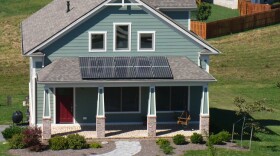The rise of solar electricity presents a good of problem to have. There is lots of power while the sun shines, but almost no way to save it for a rainy day.
There’s only one type of power plant that can store potential energy for later use. Hydro electric stations can generate electricity "on demand” and send it to the power grid in a matter of minutes, and that makes them extremely valuable during shortages.
Legislation passed earlier this year, paves the way for construction of a new hydro plant in southwestern Virginia. It’s seen as a clean energy producer and an economic driver for the region. But some worry that the renewable energy piece is being treated like an afterthought.
The largest pumped storage hydro power plant in the country has been operating in the Allegheny Mountains of Warm Springs, Virginia for 30 years. It makes electricity using rainwater, captured in a reservoir built for that purpose. The water is later pumped 12-hundred feet up a mountain, where it is stored in a smaller reservoir until needed to generate electricity. Susan Davis is Senior Environmental Compliance Coordinator there. “ And actually, the reservoir is fairly high right now so when we go up top it’s going to be fairly low because we’re just moving the same water back and forth.”
That’s known as a closed loop hydro storage system. At the Bath County plant, more of the machinery is underground than above, so what you see at the plant is hundreds of acres of breathtaking mountains and trees.
All looks serene on one of the last warm days of autumn, but any minute, a call could come in from the PJM Regional Transmission Organization in Richmond, saying there’s a shortage on the grid. That’s the cue for operators to send tons of water hurtling back down the mountain to the lower reservoir, turning electricity producing turbines on the way.
Bill Mitchell is operations and plant manager at the Bath County pumped hydro storage plant.
“The generators here, once we get a call, we can have that unit online, producing electricity in about 6 minutes,” Mitchell says. “Pumping takes a little longer. It’s about 15 minutes to start the pumps up and pump the water back into that reservoir.”
No calls for electricity came in on the day Dominion Energy invited reporters for a tour of plant, so we never got to hear the pumps start up or the water rush down. We’re told there’s not much noise and nothing can be heard beyond the plant. At full tilt, they can generate just over five hundred megawatts for about 3 hours; enough to power some three quarters of a million homes.
Dominion Energy is majority owner of the Bath Hydro Power Station and it’s looking to build another, smaller one, down south. Appalachian Power is considering joining in. Projected cost: roughly 2 billion dollars. Mike Thompson is Economic Development Director in Tazewell County, where Dominion has filed a preliminary permit application for a tract of land it owns there. “Basically, we were very, very excited." says Thompson. "This is a game changer, I think for our county.”( If the plant is ultimately located here.)
The region is full of high mountain ridges with enough elevation for the water to rush down when bidden.
If a hydro plant can be built in the region, the company estimates thousands of constructions jobs in the building phase and perhaps 50 permanent ones.
David Rouse lives in Wise County. He’s concerned the new plant would use conventionally made electricity to power the pumps that send the water uphill. “Unfortunately, Dominion isn’t telling us what their proposal is for encouraging solar rather than simply storing energy generated by burning hydro carbons."
Spencer Adkins is Dominion’s project manager. “As part of the legislation passed, there is a renewable component and we are looking into that as part of our pre-feasibility work that we’re doing. "We are trying to determine what that’s going to look like, whether, it’s going to be solar, where it’s going to be located, how much, we really don’t know yet, but there will be a renewable component to this project."
Still, some people argue the whole idea is wrongheaded. Vivian Thomson is a retired University of Virginia professor and the author of a new book called, Climate of Capitulation: An Insider’s Account of State Power in a Coal Nation. Thomson says, "The fundamental question is, why is this large, expensive facility necessary? What are the alternatives to building it and what are the alternative costs in environmental health and implications?
She wonders, “Why not lead with the renewables plan and why not lead with energy efficiency? States that have invested in energy efficiency have reduced the need for peak demand electricity. So why aren’t we looking at energy efficiency investments first rather than this hugely expensive facility
So why aren’t we looking at energy efficiency investments first, rather than this hugely expensive facility?”
That’s a question that may ultimately face regulators. A spokesman for Dominion, Dan Genest, says the company expects to know by early next year if the project could move forward at the Tazewell site, . He adds, 'there’s plenty of time to plan the required solar piece.' If approved, the pumped storage hydroelectric plant would go on line some eight to ten years after they break ground.



